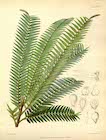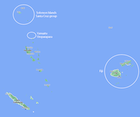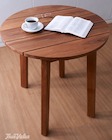Conservation Status

Retrophyllum vitiense
(Seem.) C.N. Page 1989.
Common names
Dakua salusalu, ndakua salusalu, salu-salu (Fiji); ailumu (Solomon Islands, Kwara'ae language); ngapiru (Solomon Islands: Nambalua) (Mill 2016).
Taxonomic notes
Synonymy: Podocarpus vitiensis Seeman 1862; Nageia vitiensis (Seem.) Kuntze 1891; Decussocarpus vitiensis (Seem.) de Laub. 1969 (Mill 2016). This was thought until recently to be the sole species of Retrophyllum native to the Pacific outside of New Caledonia, but Mill (2016) explains the evidence for distinguishing R. vitiense from R. filicifolium, and as the taxa are clearly distinguishable on morphological and geographic grounds, they are at a minimum assignable to different subspecies and have been described now as distinct species.
Description
Trees to 47 m tall and 450 cm dbh (trunk sometimes spur-buttressed at base on large trees), with a straight, typically single bole. Bark smooth with faint vertical fissures, flaking into small longitudinal crumbly pieces, fissured, brown, more pale in mature trees; inner bark brown, wood cream-colored. Crown compact, much branched, first pyramidal and later rounded, with pendulous twigs. Buds ovoid or obovoid; bud scales in 2 series, decussate, all equal, ovate and keeled, acute, brown with narrow pale entire margin. Ultimate juvenile shoots 130–280 mm, with 35–60 pairs of foliage leaves, occasionally biramulate. Juvenile foliage leaves 4–11 mm apart, opposite-distichous, heterofacially turned at base, diverging at 60–80°, shortly petiolate, lamina lanceolate or narrowly lanceolate, those near middle of branchlet 18–35 × 4–6 mm. Adult trees with dimorphic shoots, most shoots bearing foliage leaves but leader shoots bearing scale leaves; shoot flattening heterofacial with the decurrent leaf bases running straight down the internodes. Primary adult branches opposite-decussate or alternate. Ultimate adult foliage shoots 100–230 mm with 11–60 pairs of leaves, straight or curved. Leaf scars absent. Adult foliage leaves 4–8 mm apart, opposite-distichous, not imbricate, heterofacially twisted, shortly petiolate; lamina of most leaves spreading, diverging at 45–70°, deep green, narrowly lanceolate to lanceolate, those near middle of branchlets 16–27 × 3.2–6 mm but lowest ones shorter and more ovate, all straight, coriaceous; margin narrowly hyaline; surfaces amphistomatic, with longitudinal vein-like striae between the rows of stomata; midrib evident, raised beneath; apex subacute or obtuse, never mucronate; base rounded, obtuse or cuneate. Pollen cones solitary or 1–3 together, linear-cylindrical to ovoid; microsporophylls 44–80 per cone, in 11–15 whorls; lamina triangular to ovate or somewhat wedge-shaped with buff-coloured scarious margin; microsporangia reniform. Seed cones lateral, arising from near the base of an ultimate foliage shoot, 1 or 2 per shoot. Peduncle 2–12 mm, erect or erecto-patent when young, with 3–5 pairs of bracts below the cone axis. Cone axis formed of 6–8 sterile bracts and 1 or 2 fertile bracts. Cones obovoid or pyriform, 15–23 × 10–12 mm; epimatium initially blackish-violet, later turning bright magenta and finally becoming bluish-red when ripe, not crested, with a conical, slightly hooked beak at micropylar end; micropylar beak with two short prongs that point ± vertically downwards towards the last sterile bract. Flowers March to December; fruits June to February (Mill 2016).
This species closely resembles R. filicifolium from New Guinea and the Moluccas, but R. vitiense has tapered leaves widest close to the base, not near the middle. The pollen cones have more microsporophylls (typically 44-80 vs. 20-32 in R. filicifolium). If young seed cones are present, they have more sterile bracts on the cone axis (6-8 rather than 4), and the bracts persist until near cone maturity. Also, the receptacle is cylindrical rather than obovoid (Mill 2016).
Distribution and Ecology
Solomon Islands, Vanuatu, and Fiji. In the Solomons, confined to the Santa Cruz group, with collections on Santa Cruz and Vanikoro islands. In Vanuatu, one collection on Ureparapara Island. In Fiji, at least 23 collections on Viti Levu, with collections also on Kadavu and Vanua Levu, with most collections on the southeastern (wet) sides of the islands. Collections have occurred at elevations from 50 m to 914 m. These sites represent dense lowland rain forest, montane rain forest or ridge forest, with annual rainfall of approximately 5000 mm. In these forests, Retrophyllum typically grows as scattered trees on slopes and in gullies), commonly with Agathis, Calophyllum vitiense, Gironniera celtidifolia, Parinari insularum, Semecarpus vitiensis, and Pagiantha thurstonii (Mill 2016).
Although the IUCN has not assigned a conservation status to the species as circumscribed here, Mill (2016) discusses an assessment that considered only the species as distributed in Fiji and Solomon Islands, and concludes that a rating of "Least Concern" is likely appropriate in spite of the ongoing threat of timber harvest.
Remarkable Specimens
No data as of 2023.02.22.
Ethnobotany
An historical account from 1928 called it one of the commonest and most important timber trees of Fiji, used in boat-building. Mill (2016) describes this as currently "one of the most highly prized timber trees of Fiji", noting its use for furniture, flooring, exterior work and construction (see 2020 photo at right, of a table). The wood is not very decay-resistant and the resin is flammable, used by Fijians to start fires (Mill 2016). Several timber merchants advertise it, usually under the common name "dakua salusalu", stating the density is 440 kg/m3 and that the wood is pale brown to golden orange-brown, of fine texture, easily worked, suitable for turning, used in furniture, cabinetry, mouldings, paneling and other finish carpentry (e.g., White Cliffs Timber Ltd., accessed 2021.11.17).
Observations
It seems to be fairly widely distributed on Viti Levu in Fiji, and much less common elsewhere in its range. A cultivated specimen is reported from the Botanic Garden in Sydney, Australia. Generally, this this a very uncommon species in cultivation.
Remarks
The epithet vitiense means "of Viti", which is an alternative name for Fiji.
Citations
See also





